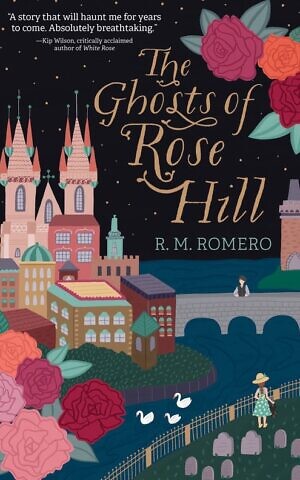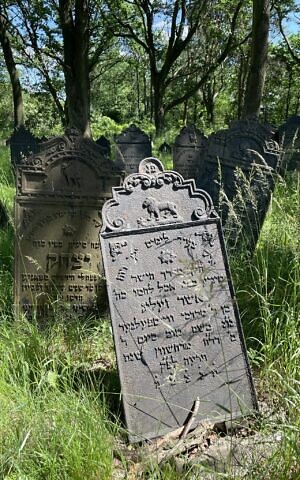Ilana, a teenage Jewish Latina from Miami Beach, is spending the summer across the ocean, in Prague. A budding violinist, Ilana feels misunderstood by her parents, who envision a more practical future for their daughter. While staying with her Aunt Žofie in the Czech capital, she falls in love with a kindred spirit — a Jewish boy named Benjamin. The thing is, Benjamin turns out to literally be a spirit.
“The Ghosts of Rose Hill,” a new young adult novel by R.M. Romero, is at once a ghost story, a love story and a paean to Jewish and Latin American diasporas, told through free verse. The book draws upon the author’s own background as a Jewish Latina as well as her volunteer work refurbishing historic Jewish cemeteries across Eastern Europe. Published earlier this year to critical acclaim, its otherworldly plot elements make it a great choice for Halloween time.
“I think ghosts are inherently romantic,” Romero told The Times of Israel. “They are always longing for the life they have lost and the world they no longer interact with.”
Lost worlds permeate the book, whether it’s Benjamin’s century-old family tragedy or the branches of Ilana’s family tree — her father’s side affected by the Prague Spring, and her mother’s side impacted by the Cuban Revolution.
In the novel, Ilana reflects on her Sephardic great-grandmothers – “They fled the pyres / (the flames / fueled by hatred) / devouring / the street corners, / synagogues, / cemeteries / of Spain, / crossing the ocean / /with their faith / and Shabbat candlesticks / tucked under their skirts” — an exodus that uncannily presaged her mother’s flight from Castro.
Noting that exile was a prominent part in the narrative of her own father — his family fled from communist Cuba from the late 1950s to the early 1980s — Romero added, “That theme is very common, obviously, for Jewish folks as well, whether exile from Israel or having to leave Europe after the Holocaust… It’s the idea of being almost in a liminal space — you’re not where you left, but you’re not where you are, either.”
As the novel begins, Ilana faces a somewhat involuntary change of place.
Convinced that her passion for the violin is detracting from her schoolwork, her parents take a drastic step. They send her to Prague to stay with the other artist in the family, Aunt Žofie. It’s not exactly a vacation. If she doesn’t perform well on the upcoming SATs, she can forget about any more music lessons. An up-close look at a starving artist’s life is also part of the plan.
Yet her parents have miscalculated. Music is a non-negotiable part of Ilana’s life — reflected in the author’s decision to write the narrative in free verse.
“Initially, I started to write verse as a challenge to myself,” Romero said. “I had always written poetry. So many fantastic young adult novels are in verse… I was going to give it a try. It became a natural format — poetry has such a musical quality, and Ilana is a musician.”
Author R.M. Romero, who wrote ‘The Ghosts of Rose Hill.’ (Courtesy)
Aunt Žofie recognizes this when her niece arrives.
“I really wanted to give Ilana a positive adult ally,” Romero said, “someone who sees why art is so important to her, who has struggled and ultimately survived.”
Meanwhile, Ilana grows bolder about exploring the environs beyond her aunt’s cottage. Out for a walk one day, she discovers a forgotten Jewish cemetery.
Here, Romero draws upon her actual experiences rehabilitating Eastern European Jewish cemeteries. She became involved in this endeavor in 2016 while fact-checking for her previous, middle-grade novel “The Dollmaker of Kraków,” which combined a Holocaust narrative with European folklore.
Through a Google search, Romero learned about a non-invasive archaeological project at Auschwitz. Romero ended up working on the project for a week and coming back to Eastern Europe each summer to do restoration work at other cemeteries. She helped cut down tall grass, including the sting nettle common to Poland, while washing the faces of matzevotor headstones.
“It’s all about honoring the dead,” she said. “It’s one kindness we call the highest in Judaism, helping the dead.”

‘The Ghosts of Rose Hill,’ by R.M. Romero. (Courtesy)
The amount of work that needs to be done varies from place to place.
“Some cemeteries are almost fully intact,” Romero said. “Czechostowa is absolutely beautiful. Many of the sites are showing wear and tear from 100 or 150 years.”
She noted, “Jewish cemeteries often became the sites of Nazi executions,” adding that this was a tragic irony because these cemeteries had been originally situated “on the outskirts of town, on hills, to prevent violence.”
The war in Ukraine has put rehabilitation projects on hold, as many of the sites are in Ukraine and Poland.
In the book, as Ilana cleans the matzevot of the cemetery, she thinks she is alone — until she meets Benjamin, who quickly makes an impact.
A romance blossoms, aided by evening walks through the city. Although Benjamin comes from a vanished world, he details a family story that resonates for Ilana.
“It seemed to feel natural for the two characters to fall in love,” Romero said. “They have so much in common — issues they had with their parents, art, being kind, empathic people with a lot of compassion for the world around them.”
It doesn’t hurt that Benjamin has Prague for a locale to show Ilana. The author recalls her own feelings of amazement when she visited the city as a teenager with her sister. Her memories of the city include the Kafka Museum and the art scene.
“It’s such an enchanting city,” Romero said. “I wanted to bring it to readers who have never been and may never go, allow them to be there for a few seconds, if only in their imagination.”

A view of the Charles Bridge in Prague, October 24, 2022. (Yaakov Schwartz/ Times of Israel)
Yet there is an unsettling side to the enchantment. Benjamin, Ilana learns, lives in a house with the ghosts of other Jewish children. Their apparent caretaker is a mysterious figure named Rudolph Wassermann. Rudolph shows an outsized interest in Ilana’s musical talent and indicates that she can stay in Prague and continue her romance with Benjamin.
As readers of good ghost stories know, this deal comes with caveats. There are already signs that Rudolph is not what he seems — he casts no shadow, after all. Suffice it to say that Romero was inspired to create his character after reading a folklore thread on Twitter and learning about Czech river spirits.
“It was not until I came up with the villain that the entire story came together,” Romero said.
With Rudolph, “I wanted to flip the myth of the blood libel on its head,” she explained. “He is this monster who specifically preys on Jewish children, devouring them even after they’re dead.”
Although Prague has a tragic history from the Holocaust, the novel’s Jewish ghosts hearken back to an earlier era — the period immediately following World War I, when the Spanish flu pandemic ravaged the globe.

An undated photo of a grave in Eastern Europe taken by R.M. Romero during one of her restoration projects. (Courtesy)
“I did want to sort of explore different eras of 20th-century Jewish life in Prague,” Romero said.
The Spanish flu became uncannily relevant a century later during the COVID-19 pandemic.
“It was actually something added in when I did edits in the fall of 2020,” Romero said. “It was the height of the pandemic, pre-vaccine.”
And yet, she describes “The Ghosts of Rose Hill” as transcending time.
“It’s timeless, even though it takes place in the present day,” Romero said. “It can be read 10 years ago or 10 years from now. It’s about the conflict between wanting to please your parents and forging your own path, and falling in love for the first time, for the young heroine, who is in an actual battle against a monster who has deceived her.”